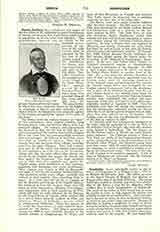

Seneca Indians, the westernmost and largest of the five tribes of the celebrated Iroquois Confederacy of central and western New York, being nearly equal in population to all the other four together. This preponderance however was due largely to the wholesale incorporation of captives in the early tribal wars, as indicated by the fact that in the ancient council of the confederacy the Seneca were represented by only eight of the fifty chiefs. They called themselves Djionondowanenronon, “People of the Great Mountain”, approximated by the French as Tsonontouan, from their principal village of that name, probably near the present Naples in Ontario County. The name Seneca, by which they were commonly known to the English, is, according to Hewitt, our best authority, a corrupted form of an Algonquian term originally applied to the Oneida, and signifying “[people of] the place of the stone”.
The Seneca held the western frontier or “door” of the confederacy, their original territory lying between Seneca Lake and Genesee River, with four principal villages; By conquest and absorption of the Neutrals in 1651 and the Erie in 1656 they acquired possession of the country westward to Niagara River and Lake Erie and correspondingly increased their own strength. In 1656 one of their four towns was made up entirely of captives. More than a century later they had some thirty villages, including several on the upper Allegany. They took a prominent part in all the tribal and colonial wars waged by the confederacy up to the close of the Revolution, taking sides like the other allied tribes almost uniformly for the English, first against the French and later against the Americans. The single exception was in 1763 when they suddenly rose against the English troops newly established in their territory, surprising and destroying two entire detachments. Their country was wasted in 1687 by Denonville and again in 1779 by the American General Sullivan, who destroyed nearly every village, cornfield, and orchard in their country, thus compelling them to peace. As a tribe they did not fly to Canada, as did the Mohawk and Cayuga in the English alliance, but remained in their own country, where they still reside on three reservations, Allegany, Cattaraugus, and Tonawanda, with a total population of 2735. About 220 more are, with others of the Six Nations, on the Grand River in Canada, while another 380 of a mixed band, formerly resident in Ohio and known as “Seneca of Sandusky”, are now settled in northeastern Oklahoma. These last appear to be really the descendants of early captives incorporated by the Seneca. The Seneca proportion among the 4000 or more Catholic Iroquois of the mission colonies of Caughnawaga, St. Regis, and Lake of Two Mountains, in Canada and northern New York, cannot be estimated, but is probably relatively less than that of the other tribes.
The Seneca came later under Catholic influence than the other Iroquois. The first converts of their tribe were instructed by the Jesuit Fathers Menard and Chaumonot, while on a journey to the Iroquois country in 1654. Two years later, on their own invitation, Father Chaumonot visited their country and was well received, organizing a temporary mission among the numerous Christian Huron captives. In 1663 a Seneca chief was baptized at Montreal, and shortly afterwards the tribe, which had been for several years at war with the French, asked for peace and missionary teachers. In November, 1668, Father Jacques Fremin dedicated the first mission chapel among the Seneca under the invocation of St. Michael, at Gandougarae (Kanagaro). In the next year Father Julien Garnier established Conception mission at Gandachiragou and began a dictionary of the language. In 1670 a third mission, dedicated to St. James, was begun by Father Pierre Raffeix in another town of the tribe. For a few years the missions flourished, in spite of more or less dangerous opposition from the heathen party, until the increasing drunkenness of the Iroquois towns and growing hostility towards the French (which latter was instigated by the English colonial Government) led to the determination to draw off the Christian Iroquois from the rest and colonize them in new mission towns along the St. Lawrence. As a result, several Christian Iroquois colonies were established, the earliest and most important being that now known as Caughnawaga, originally founded at Laprairie in 1669. Very few Christians were thus left among the confederates, but the missionaries remained among the Seneca until the eve of another general Iroquois war, in 1683, when they were ordered out by the hostiles. The leading event of this war was Denonville’s invasion of the Seneca country in 1687.
No Catholic work was subsequently attempted in the tribe, with the exception of a visit, in 1751, by the Sulpician Father Picquet, who drew off a number to his mission at Ogdensburg. The few Seneca on the Six Nations reserve in Ontario are under Episcopalian influence. The Christian portion of those in New York are chiefly of the Congregational denomination, principally owing to the devoted efforts of the Reverend Asher Wright, who labored among them over forty years (1831-75) until his death, mastering the language, in which he published a number of religious and educational works. The body of the tribe is still attached to its primitive paganism. A few of those in Oklahoma are connected with the Catholic mission of St. Mary’s at Quapaw.
JAMES MOONEY

